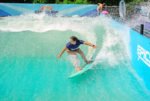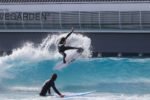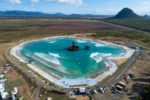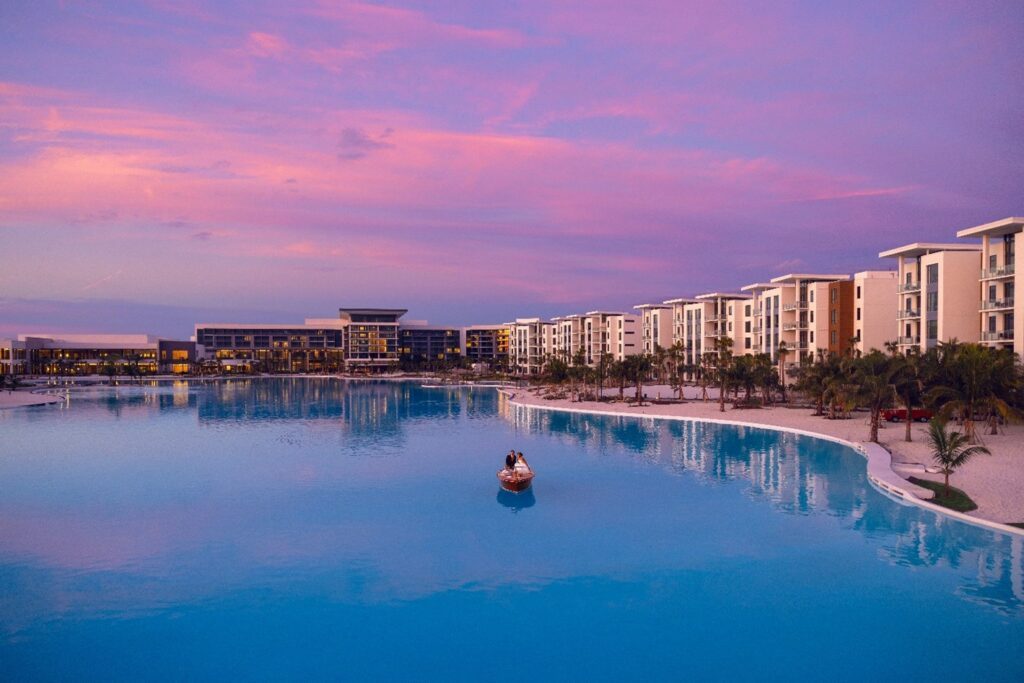Surfing is one of the fastest-growing action sports in the world. People around the globe flock to the ocean to enjoy the beaches, relax, exercise and surf. Perhaps the largest impact on the surfing industry has come from the rise of surf parks. One of the great challenges for surfers across the world is access to waves, both geographically and in terms of quality and consistency. With the advent of man-made surf pools, many of these challenges have been resolved. At a time when this sport has begun capturing new markets and segments of the population, surf parks have been instrumental in welcoming experienced and first-time surfers together in a fun, social, nonintimidating version of ocean surfing.

There currently are 17 surf parks open globally and another 47 proposed or in the planning and construction stages. With multiple surf pool technologies available, operators and investors, as well as residential and commercial developers, now are looking with great interest at the potential of this growing industry. SUPPLY The surf park sector, though young, is a fast-evolving market. There are only a handful of operational surf park lagoons worldwide, but they continue to grow in popularity around the globe. Hotel & Leisure Advisors conducted its first surf park market feasibility study in 2008 in the United States. Since then, we have been tracking the growth of this industry.

SUPPLY
The surf park sector, though young, is a fast-evolving market. There are only a handful of operational surf park lagoons worldwide, but they continue to grow in popularity around the globe. Hotel & Leisure Advisors conducted its first surf park market feasibility study in 2008 in the United States. Since then, we have been tracking the growth of this industry. The following table shows the number of surf parks open globally and those in planning (meaning proposed or under construction). These do not include projects in very preliminary stages.
In addition to surfing lessons, most surf parks offer sessions for surfers of all skill levels. Hourly session prices typically range from $40 to $50 for beginner sessions to $70 to $100 for advance.

Existing surf pools range in size from approximately 2 acres, such as BSR Surf in Waco, Texas, to approximately 5.5 acres, like at URBN Surf in Melbourne, Australia. The pools usually are capacity controlled, with a limited number of people allowed at one time to maintain safety and offer a quality experience. These capacities are defined by the size of the surfing pool and the technology utilized. Depending on location, some surf parks can operate year-round while others need to close or limit their hours during winter months.
A UNIQUE OPPORTUNITY
Man-made recreational waves have been around for generations, and the technology has continued to advance as experts try to build the “perfect wave.”
The first model suitable for surfing opened at the Big Surf Waterpark in Tempe, Ariz., in 1969. Twenty years later, Scottish engineer Douglas Murphy designed the wave pool at Typhoon Lagoon, a major attraction at Disney World in Florida and the first pool truly adapted for surfing. Murphy remained the leader of artificial wave technology until around 2010, when new technologies began to appear. Now several wave pool technologies exist. Kelly Slater’s Surf Ranch got the surfing world excited about the potential for large, competition-caliber artificial waves, while new technologies from Wavegarden, Surfloch, American Wave Machines, Whitewater, and Surf Lakes have proven it is possible to produce thousands of barreling waves per hour in a smaller lagoon. The biggest benefit of these technologies has been the ability to develop surf parks in inland locations or urban settings. Modern technologies and design allow the operator to target multiple skill levels within the same surfing session. Operators can scale the waves up or down to target different user groups. Surfing is about more than just riding waves and skill. It is a culture that fosters an outdoor lifestyle and attracts people to the oceans. Manmade surfing has the potential to bring that same culture to virtually everyone in the world. The fact that surfing debuted this year as an Olympic sport has been a catalyst for many developments and is seen favorably in the eyes of many developers, sports organizations, and government entities.
OPERATING MODELS
The development of a new surf park brings with it challenges and issues. For instance, developers and investors must assess whether such a venture is financially feasible. As the technology is relatively new, developers and operators are tweaking a variety of models to maximize the potential. We have identified two key operating models, which in some ways resemble those of waterparks.

Standalone: This type involves the development of only the surf park, with limited retail operations or food and beverage service on site. It is primarily focused on helping customers train and build their skills. During competitions and events, attendance is limited to participants and spectators. Such a venue also can function as a private club for members only. Much like a standalone waterpark, this surf park model would suit developers who have smaller sites and access to limited capital. In addition to private developers, this type would also be appropriate for cities, park districts and schools. The latter can offer surfing as a sport option or can develop surf clubs. Park districts can provide surfing lessons, clinics or camps to residents and visitors. The surfing lagoon can be turned into a giant wave pool during peak summer days for the recreation of residents. A public-private partnership could allow the city to subsidize the surf park development while offering a new and unique amenity to residents.
A public-private partnership could allow the city to subsidize the surf park development while offering a new and unique amenity to residents.
Resort or mixed-used development: In this model, the surf park is part of a larger mixed-use entertainment, retail and/or resort development. This type allows more flexibility and higher revenue potential. The surf park is part of a larger destination development that would offer on-site lodging, retail, restaurants, and/or other recreational and entertainment amenities such as a concert area, waterpark, adventure park, hiking, biking or golf. This model attracts more visitors who may or may not surf, including friends, family and curious visitors.

In addition to drawing residents of the local population, it could also serve as a tourist destination. This would require the surf park to be near or within a large population base. Surf parks will never replace the experience of riding an ocean wave. Instead, they are a means of introducing surfing to a larger population base. An example of something similar has changed how people participate in golf. By focusing on the social aspect, the company TopGolf has expanded the sport’s market base. It focused not only on existing golfers, but also on those who had never played seriously but were curious to try, with new technology and in a more relaxed setting. Similarly, modern-day surf parks can capitalize on the social appeal of surfing while teaching a new generation about it, thus broadening its allure.
KEY DRIVERS FOR SUCCESS
Several factors will determine the viability of a surf park:
- Community buy-in: The success of any venture that relies on the local population for attendance must have the community’s backing. Residents should feel invested in the project.
- Programming: Serving the needs of the community and visitors to the region requires a well-rounded and thoughtful slate of programs.
- Pricing: Surf Parks need a pricing strategy. Operators should decide not only how much to charge for sessions, but also assess how customers will react to price fluctuations, and when to raise or lower fees.
- Flexibility: Modern technologies allow for the waves to be tailored to a specific target audience, making it possible to cater to all skill levels. This flexibility is key, as it makes the venue accessible to a wider audience, rather than targeting only existing surfers
- Social aspect: To capture and keep a diverse customer base, surf parks should include family-friendly amenities, along with an active nightlife that involves concerts and music.
- Experience reinvented: A surf park needs to offer the whole package without the need to travel to the ocean. It should offer something new for consumers who are looking for the next exciting experience.
- Competition: High-tech features such as customizable waves allow for venues to turn into competition venues and host or create their own events for local surfers.
LOOKING TO THE FUTURE
As the technology catches up with opportunity, surf parks are finding their day in the sun. In a handful of years, these properties have reimagined the sport of surfing. People who might not otherwise consider the sport now will be more inclined to, thanks to these safe, convenient, non-intimidating and accessible venues.
With development costs ranging from $20 million to $50 million, and multiple operating models, developers and investors need to analyze usage, pricing and other on-site revenue-generating outlets to determine total revenue potential. A thorough market feasibility and financial analysis study should be performed to justify that the project is financially viable.
About the Author:
Nuresh Maredia is the Director of Appraisal & Consulting Services at Hotel & Leisure Advisors (H&LA), a national hospitality consulting firm. H&LA produces reports that assist clients in the hospitality and attractions, real estate industry. H&LA specializes in appraisals, feasibility studies, impact analyses, economic impact studies, and litigation support for hotels, resorts, waterparks, casinos, attractions, conference and convention centers, golf courses, ski resorts and other leisure real estate. Our consultants have analyzed and prepared studies on more than 2,000 properties in more than 45 states, Canada, and the Caribbean. You can reach Nuresh in our San Antonio office via email at nmaredia@hladvisors.com or via phone at 210-319-5440. Nuresh would also like to thank Aquatics International for publishing the article in their September 2021 edition.


